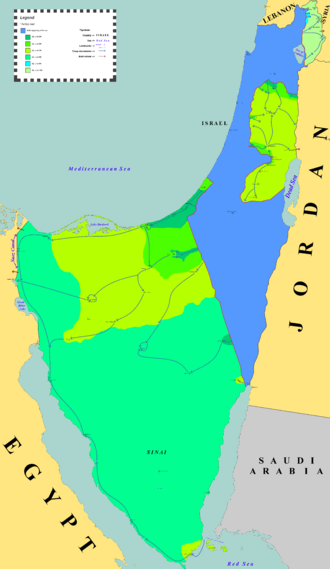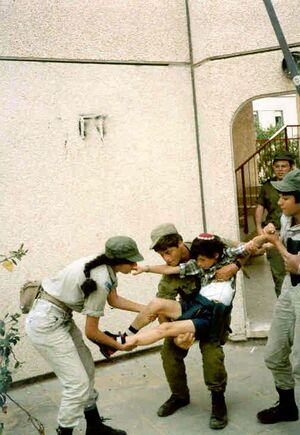الاحتلال الإسرائيلي لشبه جزيرة سيناء
| جزء من الصراع الإسرائيلي العربي، العدوان الثلاثي، حرب 1967 | |
 الأراضي التي احتلتها إسرائيل أثناء حرب 1967. | |
| التاريخ | 29 أكتوبر 1956 – 7 مارس 1957 (الاحتلال الأول) 5 يونيو 1967 – 25 أبريل 1982 (الاحتلال الثاني) |
|---|---|
| الموقع | شبه جزيرة سيناء، مصر |
| الدافع | إحباط الحصار المصري لإسرائيل (1949–1967) |
| النتائج | معاهدة السلام الإسرائيلية المصرية |
| الحكم |
|
تعرضت شبه جزيرة سيناء المصرية، للاحتلال الإسرائيلي مرتين منذ بدء الصراع الإسرائيلي العربي: الاحتلال الأول من أكتوبر 1956 حتى مارس 1957، والاحتلال الثاني من يونيو 1967 حتى أبريل 1982. استولت إسرائيل في البداية على شبه جزيرة سيناء أثناء العدوان الثلاثي، الذي شاركت فيه فرنسا وبريطانيا وإسرائيل عندما أغلقت مصر طرق الشحن الإسرائيلية؛ كان المصريون يعارضون حرية إسرائيل في الملاحة عبر مضيق تيران وقناة السويس منذ عام 1949، مما أثر على قدرة البلاد على استيراد وتصدير السلع خلال فترة التقشف في إسرائيل. على الرغم من أن الاحتلال سمح لإسرائيل بإعادة فتح مضيق تيران، إلا أن قناة السويس ظلت مغلقة حتى عام 1957، عندما انسحبت القوات الإسرائيلية من مصر. في منتصف الستينيات، وسط تحذيرات من المسؤولين الإسرائيليين من أن الحصار الآخر سيكون "سبباً للحرب"، أعادت مصر فرض الحصار على إسرائيل وخسرت لاحقاً شبه جزيرة سيناء في حرب 1967. وكما حدث من قبل، سمح احتلال إسرائيل لها بإعادة فتح مضيق تيران، ولكن مرة أخرى، أغلقت مصر قناة السويس عام 1975. وعلى مدى السنوات الثلاث التالية، سعت مصر إلى استعادة الأراضي التي فقدتها، وأطلقت حرب الاستنزاف ضد إسرائيل. لاحقاً، أدى هجوم عسكري مصري واسع النطاق ضد إسرائيل، والمعروف باسم العملية بدر، إلى اندلاع حرب 6 أكتوبر 1973، والتي انتهت باحتفاظ الإسرائيليين بالسيطرة على شبه جزيرة سيناء. وبحلول عام 1979، نجحت الولايات المتحدة في التفاوض على معاهدة السلام الإسرائيلية المصرية: اعترف المصريون بإسرائيل كدولة ذات سيادة، واعترفوا بمضيق تيران وخليج العقبة كممرات مائية دولية، ووافقوا على نزع السلاح على امتداد حدود إسرائيل. وفي المقابل، وافقت إسرائيل على سحب جميع المدنيين والجنود من شبه جزيرة سيناء وإعادتها إلى مصر. وفي 25 أبريل 1982، انتهى انسحاب إسرائيل وتركت مصر منذ ذلك الحين شبه جزيرة سيناء منزوعة السلاح، مما يمثل أول حالة سلام بين إسرائيل ودولة عربية.[1]
بين عامي 1967 و1982، بنت إسرائيل 18 مستوطنة في جميع أنحاء شبه جزيرة سيناء، وخاصة على امتداد خليج العقبة وفي المناطق الواقعة إلى الجنوب من قطاع غزة الذي كان تحت الإدارة المصرية. بالإضافة إلى ذلك، قامت إسرائيل بتفكيك قاعدتين للقوات الجوية الإسرائيلية، وقاعدة واحدة للبحرية الإسرائيلية، وعدد من المنشآت الحكومية/العسكرية الأخرى، بما في ذلك معظم موارد النفط التي تسيطر عليها إسرائيل.
خلفية
العدوان الثلاثي على مصر (1956)
استولت القوات الإسرائيلية على شبه جزيرة سيناء المصرية لأول مرة أثناء العدوان الثلاثي في أكتوبر ونوفمبر 1956. وتحت ضغط دولي شديد، انسحبت القوات الإسرائيلية في مارس 1957، بعد رسم خرائط مفصلة للمنطقة ووضع مخابئ إمدادات سرية استعداداً للحرب التالية. وكجزء من شروط الانسحاب الإسرائيلي، نُزع السلاح من شبه جزيرة سيناء وتشكلت قوة الطوارئ الأولى التابعة للأمم المتحدة هناك لمراقبة الحدود بين إسرائيل ومصر.
Six-Day War through Israeli withdrawal (1967-1982)
In May 1967, Egyptian President Gamal Abdel Nasser ordered the withdrawal of this force and moved Egypt's own troops into the area. Israel, believing war to be imminent, ultimately launched a preemptive strike against Egypt, beginning the Six-Day War. Within three days, Israel had occupied most of the Sinai Peninsula.
Following the Israeli capture and occupation of the Sinai Peninsula, Egypt launched the War of Attrition (1967–1970) aimed at forcing Israel to withdraw from the Sinai Peninsula. The war saw protracted conflict in the Suez Canal Zone, ranging from limited to large scale combat. Israeli shelling of the cities of Port Said, Ismailia, and Suez on the west bank of the canal, led to high civilian casualties (including the virtual destruction of Suez), and contributed to the flight of 700,000[2] Egyptian internal refugees. Ultimately, the war concluded in 1970 with no change in the front line.[3] On 6 October 1973, Egypt commenced Operation Badr to retake the Sinai Peninsula, while Syria launched a simultaneous operation to retake the Golan Heights, thereby beginning the Yom Kippur War (known in Egypt and much of Europe as the October War). The canal was reopened in 1975, with President Sadat leading the first convoy through the canal aboard an Egyptian destroyer. In 1979, Egypt and Israel signed a peace treaty in which Israel agreed to withdraw from the entirety of the Sinai Peninsula. Israel subsequently withdrew in several stages, ending on 26 April 1982.[4]
Israeli settlements

Israeli settlements in the Sinai Peninsula were split into two regions: one along the Mediterranean coast, and another along the Gulf of Aqaba.[5] Israel had plans to expand the settlement of Yamit into a city of up to 200,000 residents.[6] The actual population of Yamit never exceeded 3,000.[7] The settlements in the Yamit region were demolished by Israel prior to the withdrawal, but the settlements on the gulf: Ofira (Sharm el-Sheikh), Di Zahav (Dahab), and Neviot (Nuweiba) remained intact, and were further developed by Egypt after the withdrawal.
Yamit
- Yamit
- Avshalom, Sinai
- Netiv HaAsara, Sinai
- Holit
- Dikla
- Pri'el, Sinai
- Sufa, Sinai
- Talmei Yosef, Sinai
Gulf of Aqaba
See also
References
- ^ "Upon completion of the interim withdrawal provided for in Annex I, the parties will establish normal and friendly relations, in accordance with Article III (3)." Frank Thompson (1978). Jimmy Carter. US Government Printing Office. p. 496. ISBN 0-16-058935-5.
- ^ Spencer, Tucker. Encyclopedia or the Arab-Israeli Conflict. p. 175.
- ^ "War of Attrition". Encyclopedia Britannica.
- ^ Shipler, David K.; Times, Special to The New York (1982-04-26). "Israeli Completes Pullout, Leaving Sinai to Egypt". The New York Times (in الإنجليزية الأمريكية). ISSN 0362-4331. Retrieved 2019-06-04.
- ^ Middle East Research and Information Project (MERIP) (1977) MERIP Reports 60, p. 20
- ^ The Arab–Israeli Dilemma (Contemporary Issues in the Middle East), Syracuse University Press; 3rd edition (August, 1985 ISBN 0-8156-2340-2
- ^ Kintera.org—The Giving Communities Archived 2006-03-01 at the Wayback Machine. Theisraelproject.org. Retrieved on 2012-01-15.